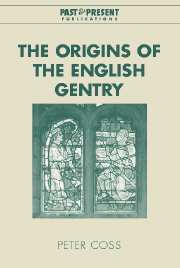Book contents
- Frontmatter
- Contents
- List of illustrations
- Preface
- 1 The formation of the English gentry
- 2 The roots of the English gentry
- 3 The Angevin legacy: knights as jurors and as agents of the state in the reign of Henry III
- 4 The crisis of the knightly class revisited
- 5 Knights in politics: minor landowners and the state in the reign of Henry III
- 6 Knighthood, justice and the early Edwardian polity
- 7 The explosion of commissions and its consequences
- 8 Identity and the gentry
- 9 Knights, esquires and the origins of social gradation in England
- 10 Crystallisation: the emergence of the gentry
- Appendices
- Bibliography
- Index
- Past and Present Publications
4 - The crisis of the knightly class revisited
Published online by Cambridge University Press: 10 December 2009
- Frontmatter
- Contents
- List of illustrations
- Preface
- 1 The formation of the English gentry
- 2 The roots of the English gentry
- 3 The Angevin legacy: knights as jurors and as agents of the state in the reign of Henry III
- 4 The crisis of the knightly class revisited
- 5 Knights in politics: minor landowners and the state in the reign of Henry III
- 6 Knighthood, justice and the early Edwardian polity
- 7 The explosion of commissions and its consequences
- 8 Identity and the gentry
- 9 Knights, esquires and the origins of social gradation in England
- 10 Crystallisation: the emergence of the gentry
- Appendices
- Bibliography
- Index
- Past and Present Publications
Summary
As is well known, the first half of the thirteenth century saw a thinning of knightly ranks and the development of a more exclusive knighthood in England. By the 1240s the powerful force exerted by a fully fledged chivalric knighthood was forcing earlier connotations firmly into the background. The rather inclusive Angevin conception of knighthood, with its heavy service component, was fast giving way before a new and rather narrow elitism. Among the expressions of this was the separation of knights from others in charter witness lists so that the knights and the greater lords, and only they, were designated dominus or sir. Another was the knightly effigy, now making its first serious inroads into the churches. A third was heraldry, manifested not only in the appearance of rolls of arms but increasingly as a visual expression of status within the public sphere.
It is important to emphasise that this new, exclusive knighthood was no surface matter, a mere shift of emphasis. On the contrary, it was a development of momentous importance in the history of gentility. A fundamental social divide was emerging between the knights, including the great lords who were also of course knights, and the rest, including the erstwhile knight-bearing families below them. It is one thing, however, to observe such phenomena; it is quite another to explain them and to address their historical significance.
- Type
- Chapter
- Information
- The Origins of the English Gentry , pp. 69 - 108Publisher: Cambridge University PressPrint publication year: 2003

